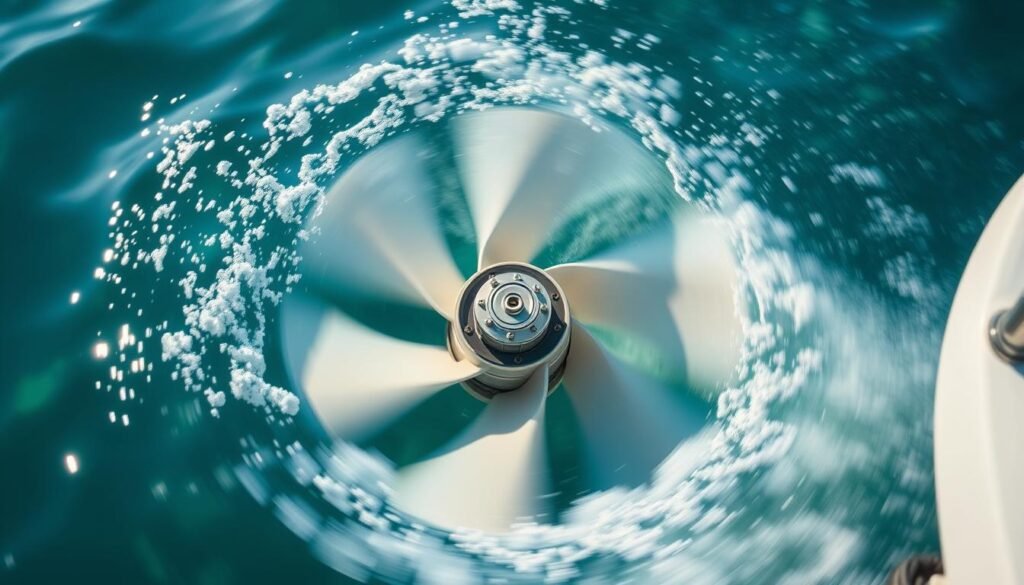The impeller is a crucial part of marine engine cooling systems. It’s a small, flexible component, often made of rubber or nitrile, that ensures the engine stays cool. By drawing in raw water, it plays a vital role in preventing overheating.
This component relies on suction and rotation to move water through the pump. Without proper lubrication, the impeller can disintegrate in a short time. Running dry, even for a minute, can cause significant damage.
Regular maintenance is essential to keep the system efficient. Ensuring the impeller is never run dry and stays lubricated will extend its lifespan. This article will explore the risks and best practices for maintaining your marine engine’s cooling system.
Understanding Boat Engine Impeller Components and Design
Impellers are the unsung heroes of marine engine cooling systems. These small yet vital components ensure that engines stay cool and operate efficiently. Their design and materials play a crucial role in their performance and longevity.
Materials and Construction of Impellers
Impellers are typically made from rubber or nitrile compounds. These materials are chosen for their flexibility, durability, and resistance to wear and heat. The vanes, or blades, are designed to draw and expel water effectively, ensuring smooth operation.
Here’s a comparison of common materials used in impeller construction:
| Material | Properties | Best Use |
|---|---|---|
| Rubber | Flexible, cost-effective, good for moderate temperatures | Recreational boats |
| Nitrile | High heat resistance, durable, ideal for harsh conditions | Commercial marine engines |
Role in the Marine Engine Cooling System
Impellers are a critical part of the engine cooling system. They work within the pump housing to draw water from the surrounding environment. This water is then circulated to cool the engine, preventing overheating and ensuring optimal performance.
Proper design reduces friction and wear, extending the impeller’s lifespan. Regular maintenance, such as lubrication and inspection, is essential to keep the system running smoothly. By understanding the components and their roles, you can ensure your marine engine remains reliable and efficient.
How does a boat impeller work – Key Functions and Operation
Efficient water flow in marine engines depends on the impeller’s design and operation. This component uses high-speed rotation to create suction, drawing in raw water and pushing it through the cooling system. Without this process, the engine would overheat quickly.

Water Pumping Mechanics and Suction Principles
The impeller’s rotation generates a vacuum, pulling water into the pump housing. As the vanes open, they draw water in. When they close, the water is forced outward, creating a continuous flow. This process ensures the engine stays cool.
Here’s a breakdown of the suction and pressure dynamics:
| Stage | Action | Result |
|---|---|---|
| Suction | Vanes open, creating a vacuum | Water is drawn into the pump |
| Pressure | Vanes close, compressing water | Water is pushed through the system |
Interaction with the Pump Housing and Vanes
The impeller and pump housing work together to maintain an uninterrupted water flow. The housing channels the water, while the vanes optimize intake and expulsion. Proper lubrication is critical to prevent wear and ensure smooth operation.
“Running an impeller dry, even for a minute, can cause irreversible damage. Always ensure proper lubrication and maintenance.”
Regular inspection and maintenance are essential to keep the system efficient. By understanding these mechanics, you can extend the lifespan of your marine engine’s cooling system.
Maintenance, Replacement, and Repair Tips
Proper maintenance ensures the longevity of marine engine cooling systems. Regular care of the impeller and pump housing prevents overheating and costly repairs. Focus on lubrication, safety, and using the right tools for replacements.
Lubrication Techniques and Safety Considerations
Lubricating the impeller and pump shaft is essential for smooth operation. Use durable, waterproof grease approved by pump manufacturers. This prevents seizure and reduces wear on the vanes.
Always ensure the system is not run dry, as it can cause the impeller to disintegrate quickly. Safety precautions include wearing gloves and using proper tools to avoid damaging components.
“Running an impeller dry, even for a minute, can cause irreversible damage. Always ensure proper lubrication and maintenance.”
Tools and Best Practices for Impeller Replacement
Removing a worn impeller can be challenging. Avoid using screwdrivers, as they can damage the pump housing. Instead, use specialized tools like impeller pullers for safe removal.
- Replace the gasket or O-ring on the face plate during every replacement.
- Apply grease to ensure a secure, leak-free seal.
- Check for seepage and confirm proper alignment of splines before reassembly.
After replacement, run the engine to inspect for issues. Following these steps ensures the cooling system remains efficient and reliable.
Conclusion
Understanding the role of the impeller in marine systems ensures safe and efficient navigation. This small yet vital component keeps the engine cool by drawing water into the pump housing and circulating it through the system. Proper lubrication and regular maintenance are key to its longevity.
Timely repairs and inspections prevent costly engine damage. Always follow manufacturer recommendations for replacement and ensure the impeller is never run dry. These steps not only extend the life of the cooling system but also enhance overall engine performance.
By prioritizing maintenance, boat owners can enjoy reliable navigation and avoid unexpected breakdowns. A well-maintained impeller is essential for both safety and efficiency on the water.
